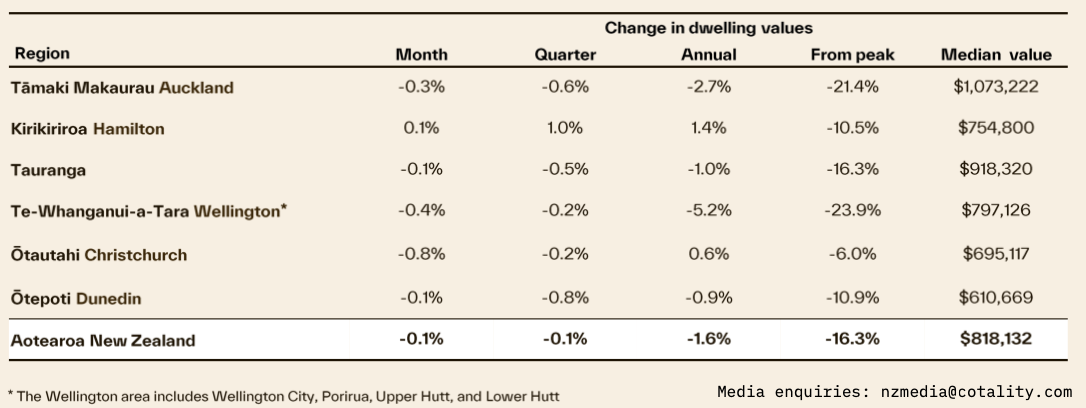Recent data reveals patchy trends across urban and regional areas

Aotearoa New Zealand’s property market saw a slight dip in May, with national property values edging down by -0.1%, according to the latest Cotality Hedonic Home Value Index. This marginal decrease follows a period of modest gains in previous months, bringing the national median value to $818,132. Despite recent movements, values remain -1.6% below levels recorded a year ago and are a significant -16.3% shy of the January 2022 peak.
Main centres show mixed performance
May proved to be a mixed bag for New Zealand’s main urban centres. Kirikiriroa Hamilton experienced a slight uptick of +0.1%, offering a glimmer of positive movement. However, other major cities saw values decline. Ōtepoti Dunedin and Tauranga both recorded a -0.1% decrease, while Tāmaki Makaurau Auckland dipped by -0.3%. Te Whanganui-a-Tara Wellington faced a -0.4% fall, and Ōtautahi Christchurch, after a period of relative stability, saw the largest drop among the main centres at -0.8%.

Within Tāmaki Makaurau Auckland, sub-markets presented a varied picture. Rodney saw a +0.4% rise and Franklin increased by +0.2%, with Waitakere remaining steady. Conversely, Auckland City and Manukau both decreased by -0.3%, and Papakura (-0.6%) and North Shore (-1.0%) experienced larger declines.
Te Whanganui-a-Tara Wellington also exhibited inconsistent patterns, with Lower Hutt managing a small increase of +0.1%, while Upper Hutt, Kāpiti Coast, and Porirua all edged downwards. Wellington City itself recorded a -0.7% drop.
Regional markets show more resilience
In contrast to the patchy performance of the main centres, several provincial markets demonstrated greater resilience in May. Tāhuna Queenstown notably rose by +1.2%, recouping modest declines from March and April. Waihōpai Invercargill also saw a healthy increase of +0.5%, with Rotorua, Ngāmotu New Plymouth, and Heretaunga Hastings all registering positive growth. Most other regional centres remained largely flat or experienced only minor reductions.
Kelvin Davidson (pictured), chief property economist at Cotality NZ (formerly CoreLogic), said that the May figures serve as a reminder that any emerging housing upturn could remain slow and variable across both months and regions. He attributed some bolstering of household confidence to lower mortgage rates and signs of increased loan-to-value and debt-to-income ratio lending activity.
However, Davidson cautioned against over-optimism.
“Housing isn’t necessarily affordable in absolute terms, while the economy and labour market remain subdued too,” he said. “Indeed, filled jobs edged lower again in April. These are certainly restraints on buyers’ willingness to push ahead with property deals or to pay higher prices.”
He noted that while May’s national drop was minor and potentially reversible, those anticipating a sharp and widespread increase in property values in 2025 continue to face disappointment.
What are your thoughts on the recent findings? Share your insights below.



